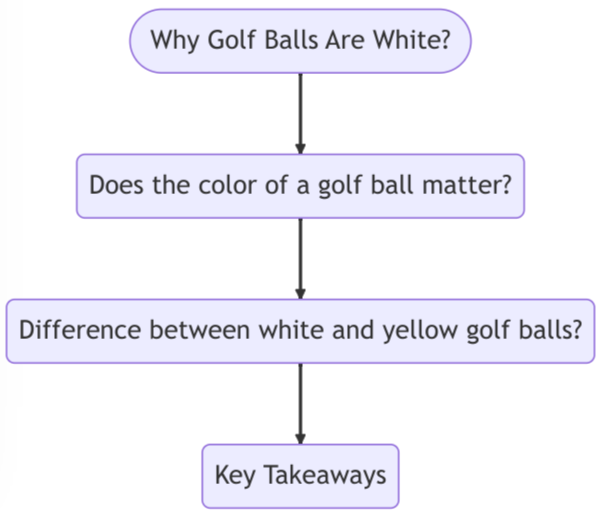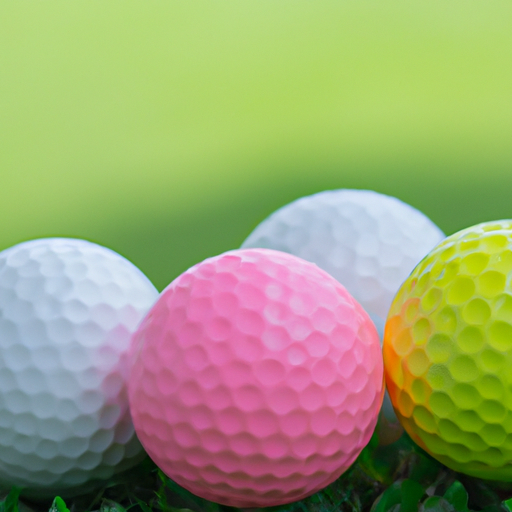- Home
- Guide
- Golf Questions
- Why Are Golf Balls White
Why Golf Balls Are White: Unveiling the Mystery
Have you ever been on the golf course and suddenly found yourself asking, "Why are golf balls white?"
If so, you're not alone.
As an avid golfer, I too found myself pondering this question, and I knew I needed to find the answers. Not just for myself, but for my fellow weekend warriors who have also wondered about the color of these little dimpled spheres.
Diving into the history of golf balls, I stumbled upon some fascinating facts that I just had to share with you. In this article, we'll explore the origins of the white golf ball, the role of color in golf, and whether it truly affects our performance on the course.
Imagine hitting the course with newfound knowledge about the mysterious white golf ball, impressing your buddies, and even potentially improving your game. As you read on, you'll unveil the truth behind this age-old enigma and discover how a simple change in color could change the way you approach the game.
Don't miss out on the opportunity to learn something new and exciting about the sport we all love. Are you ready to uncover the mystery behind the color of golf balls and possibly transform your golfing experience? Read on, and let's embark on this captivating journey together.
Why Are Golf Balls White?
As a weekend golfer, I'm no stranger to the nagging questions that can haunt us.
One day, as I was admiring my new set of clubs, I couldn't help but wonder: Why are golf balls white? And, more importantly, does the color of a golf ball really matter?
I knew I had to find the answers, not just for myself, but for my fellow weekend warriors. So I embarked on a journey to uncover the truth behind the color of golf balls, and what I found may surprise you.
A Brief History of Golf Ball Colors
Golf balls haven't always been white.
In fact, back in the day, they were made of wood or leather stuffed with feathers, and their natural color varied. It wasn't until the late 19th century, when the gutta-percha ball was introduced, that golfers started to paint their balls white.
The gutta-percha material was dark, making it difficult for golfers to spot their balls on the course. Painting them white made them more visible against the green grass, helping golfers track their shots more easily.
But, the real shift happened when the modern golf ball, made of rubber and covered with a dimpled urethane, became the standard. Manufacturers chose white as the default color, and it has stuck ever since.
Does The Color Of A Golf Ball Matter?
While it's true that white golf balls are easier to spot on the course, is there any real advantage to using a white ball?
The answer is: not really.
Color doesn't affect the performance of a golf ball. It's all about personal preference and visibility.
There are a few factors to consider when choosing a color:
Visibility: Depending on the course and weather conditions, certain colors may be easier to spot than others. For example, yellow balls are easier to see in foggy or overcast conditions, while orange balls stand out against the autumn foliage.
Personal Preference: If you love a particular color, go for it! There's no rule saying you have to stick to white golf balls. Many golfers find that using a colored ball can help them focus and improve their game.
Identification: Using a unique colored golf ball can help you quickly identify your ball among others on the course, saving time and reducing the risk of playing the wrong ball.
Does The Golf Ball Have To Be White?
No, the golf ball doesn't have to be white.
In fact, there are many colorful options available on the market today. You can find golf balls in a wide range of colors, including yellow, orange, pink, and even multi-colored balls.
These colored balls offer the same performance as white balls but can provide added benefits, like improved visibility in certain conditions or helping you stand out on the course.
Is There Any Difference Between White And Yellow Golf Balls?
The primary difference between white and yellow golf balls is visibility.
Yellow balls are often easier to spot against the green grass, especially in low-light conditions. Other than that, there is no significant difference in performance between the two colors.
Some say that the increased visibility helps golfers track the ball more easily, leading to more accurate shots and better overall play, but I don’t know how true that is...
My Journey: From White to Yellow
I used to be a staunch supporter of the classic white golf ball. But one day, as I was about to tee off, I realized I had forgotten to pack my white balls. All I had left were a few yellow balls I had received as a gift.
Reluctantly, I decided to give the yellow balls a try. To my surprise, I noticed that I could spot my ball much more easily on the course. The vibrant color stood out against the grass, helping me track my shots more accurately.
Over time, I found that using yellow balls actually improved my game. I was hitting longer and straighter shots, lowering my score, and consistently winning against my buddies. And the best part? I was no longer humiliated on the first tee.
I realized that the "dirty little secrets" the pros knew weren't about the color of the ball, but rather about adapting and finding what works best for each individual golfer. My ultimate fantasy of hitting long drives off every tee and shocking my buddies with my improved skill became a reality – all thanks to a simple color change.
Don't be afraid to try something new. Sometimes, it's the smallest changes that can make the biggest difference in your game.
(UPDATE: I’m back to playing white golf balls, and my game is still good.)
Ready To Switch Up Your Golf Ball Color?
If you're curious about trying a different color golf ball, don't be afraid to experiment. Remember, there's no rule that says golf balls have to be white – it's all about personal preference and visibility.
Now that you know the truth behind the color of golf balls, why not give a new hue a try and see if it can improve your game? Who knows, you might just find your new favorite ball and change your golfing world one round at a time.
Key Takeaways
1. Golf balls are white primarily for visibility reasons, but they don't have to be white.
2. Color doesn't affect the performance of a golf ball – it's all about personal preference and visibility.
3. Yellow golf balls can improve visibility and potentially enhance your performance on the course.
4. Don't be afraid to experiment with different colored golf balls to find what works best for you.
Frequently Asked Questions About Golf Ball Colors
What materials were used to make golf balls in the past?
What materials were used to make golf balls in the past?
Historically, golf balls were made from leather stuffed with feathers. The color of these balls varied naturally.
Why did golfers start painting golf balls white?
Why did golfers start painting golf balls white?
Golfers started painting their golf balls white in the late 19th century when the gutta-percha ball was introduced. The gutta-percha material was dark, and painting the balls white made them more visible against the green grass.
Do colored golf balls perform differently than white ones?
Do colored golf balls perform differently than white ones?
No, the color of a golf ball does not impact its performance. The primary difference between colored golf balls and white ones is visibility.
What are the advantages of using colored golf balls?
What are the advantages of using colored golf balls?
Colored golf balls can be easier to spot on the course, depending on the weather and course conditions. They can also help players quickly identify their ball among others and may improve focus.
What colors do golf balls come in?
What colors do golf balls come in?
Golf balls come in a wide range of colors, including yellow, orange, pink, and multi-colored options.
Are there any rules about the color of golf balls in competitions?
Are there any rules about the color of golf balls in competitions?
There are no specific rules regarding the color of golf balls in competitions. Players are free to use any color they prefer, as long as the ball meets other regulatory requirements.
Can I customize the color of my golf balls?
Can I customize the color of my golf balls?
Yes, many companies offer customized golf balls, allowing you to choose your preferred color or even print a logo or text on the ball. This can be a fun way to personalize your game and make your golf balls stand out on the course.








